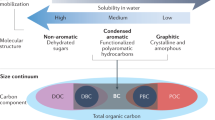Abstract
The simulation model accounts for four major compartments in the global carbon cycle: atmosphere, ocean, terrestrial biosphere and fossil carbon reservoir. The ocean is further compartmentalized into a high and a low latitude surface layer, and into 10 deep sea strata. The oceanic carbon fluxes are caused by massflow of descending and upwelling water, by precipitation of organic material and by diffusion exchange.
The biosphere is horizontally subdivided into six ecosystems and vertically into leaves, branches, stemwood, roots, litter, young humus and stable soil carbon. Deforestation, slash and burn agriculture, rangeland burning and shifts in land use have been included. The atmosphere is treated as one well mixed reservoir. Fossil fuel consumption is simulated with historic data, and with IIASA scenario's for the future. Using the low IIASA scenario an atmospheric CO2 concentration of 431 ppmv is simulated for 2030 AD. A sensitivity analysis shows the importance of different parameters and of human behaviour. Notwithstanding the large size of the biosphere fluxes, the atmospheric CO2 concentration in the next century will be predominantly determined by the growth rate of fossil fuel consumption.
Similar content being viewed by others
References
Ajtay, G. L., Ketner, P., and Duvigneaud, P.: 1979, ‘Terrestrial Primary Production and Phytomass’, in B. Bolin, E. T. Degens, S. Kempe, and P. Ketner (eds.), The Global Carbon Cycle, Scope Report No. 13, Wiley, New York, pp. 129–187.
Bacastow, R. and Keeling, C. D.: 1973, ‘Atmospheric Carbon Dioxide and Radio Carbon in the Natural Carbon Cycle: II Changes from AD 1700 to 2070 as Deduced from a Geochemical Model’, in G. M. Woodwell and E. V. Pecan (eds.), Carbon and the Biosphere, NTIS U.S. Dept. of Commerce, Springfield, Virginia, AEC Symp. Ser. 30, pp. 86–135.
Björkström, A.: 1979, ‘A Model of CO2 Interaction between Atmosphere, Oceans and Land Biota’, in B. Bolin et al. (eds.), The Global Carbon Cycle, Scope13, Wiley, New York, pp. 403–457.
Breman, H., Cissé, I. B., et Djitèye, M. A.: 1982, ‘Exploitation, degradation et desertification’, in F. W. T. Penning de Vries et M. A. Djitèye (eds.), La productivité des pâturages sahéliens, Pudoc, Wageningen, pp. 378–385.
Broecker, W. S. and Peng,T. H.: 1974, ‘Gas Exchange Rate between Air and Sea’, (Tellus 26, 21–35). Cooper, J. P. (ed.): 1975, Photosynthesis and Productivity in Different Environments,IBP 3. Cambridge University Press, 715 pp.
De Vooys, C. G. N.: 1979, ‘Primary Production in Aquatic Environments’, in B. Bolin et al. (eds.), The Global Carbon Cycle, Wiley, New York, pp. 259–292.
Eckholm, E. P.: 1976, Losing Ground. Environmental Stress and World Food Prospects, Norton, New York, 223 pp.
Fraser, P. J., Hyson, P., and Pearman, G. I.: 1980, ‘Global Atmospheric Carbon Dioxide Space and Time Variability: An Analysis, with Emphasis on New Data, for Model Validation’, in G. I. Pearman (ed.), Carbon Dioxide and Climate, Australian Academy of Science, Canberra, pp. 49–59.
Gifford, R. M.: 1979, ‘Growth and Yield of CO2-enriched Wheat under Water-Limited Conditions’, Aust. J. of Plant Physiol. 6, 367–378.
Gifford, R. M.: 1980, ‘Carbon Storage by the Biosphere’, in G. I. Pearman (ed.), Carbon Dioxide and Climate, Australian Academy of Science, Canberra, pp. 167–181.
Gordon, A. L.: 1971, ‘Oceanography of Antarctic Waters’, AGU Antarct. Res. Ser. 15, 169–203.
Goudriaan, J. and van Laar, H. H.: 1978, ‘Relations between Leaf Resistance, CO2-concentration and CO2-assimilation in Maize, Beans, Lalang Grass and Sunflower’, Photosynthetica 12, 241–249.
Goudriaan, J. and de Ruiter, H. E.: 1983, ‘The Effect of CO2 Enrichment in Interaction with Shortage of Either Nitrogen or Phosphorus on Plant Growth’, Neth. J. Agric. Sci. 31, 157–169.
Kohlmaier, G. H., Kratz, G. H., Bröhl, and Siré, E. O.: 1981, ‘The Source-Sink Function of the Terrestrial Biota within the Global Carbon Cycle’, in W. J. Mitsch, R. W. Bosserman, and J. M. Klopatek (eds.), Energy and Ecological Modelling. Elsevier Sci. Publ. Co. Amsterdam, pp. 57–68.
Kortleven, J.: 1963, Kwantitatieve Aspecten van Humusopbouw en Humusafbraak, Pudoc, Wageningen, 106 pp.
Larcher, W.: 1980, Physiological Plant Ecology, Springer-Verlag, Berlin, 303 pp.
Louwerse, W.: 1980, ‘Effects of CO2 Concentration and Irradiance on the Stomata Behaviour of Maize, Barley and Sunflower Plants in the Field’, Plant, Cell and Environment 3, 391–398.
MacIntyre, F.: 1980, ‘The Absorption of Fossil-Fuel CO2 by the Ocean’, Oceanologica Acta 3, 505–516.
Manabe, S. and Wetherald, R. T.: 1975, ‘The Effects of Doubling the CO2 Concentration on the Climate of a General Circulation Model’, J. Atmos. Sci., 32, 3–15.
Oeschger, H., Siegenthaler, U., Schotter, U., and Gugelmann, A.: 1975, ‘A Box Diffusion Model to Study the Carbon Dioxide Exchange in Nature, Tellus 27, 168–192.
Pearman, G. I. (ed.): 1980, Carbon Dioxide and Climate: Australian Research. Australian Academy of Science, Canberra, 217 pp.
Rosenberg, N. J.: 1981, ‘The Increasing CO2 Concentration in the Atmosphere and its Implication on Agricultural Productivity’, Climatic Change 3, 265–279.
Rotty, R. M.: 1980, ‘Past and Futur Emissions of CO2’, Experientia 36, 781–787.
Schipper, P. G.: 1981, Toekomstig Verbruik van Fossiele Brandstoffen en de Emissie van Kooldioxide, Centrum voor Energievraagstukken TNO, Apeldoorn, 36 pp.
Seiler, W. and Crutzen, P. J.: 1980, ‘Estimates of Gross and Net Fluxes of Carbon between the Biosphere and the Atmosphere from Biomass Burning’, Climatic Change 2, 207–247.
Siré, E. O., Kohlmaier, G. H., Kratz, G., Fischbach, U., and Bröhl, H.: 1981, ‘Comparative Dynamics of Atmosphere-Ocean Models within the Description of the Perturbed Global Carbon Cycle’, Z. Naturforsch. 36a, 233–250.
United Nations: 1977, Desertification: Its Causes and Consequences, Pergamon Press, New York.
Viecelli, J. A., Ellsaesser, H. W., and Burt, J. E.: 1981, ‘A Carbon Cycle Model with Latitude Dependence’, Climatic Change 3, 281–302.
Author information
Authors and Affiliations
Rights and permissions
About this article
Cite this article
Goudriaan, J., Ketner, P. A simulation study for the global carbon cycle, including man's impact on the biosphere. Climatic Change 6, 167–192 (1984). https://doi.org/10.1007/BF00144611
Received:
Revised:
Issue Date:
DOI: https://doi.org/10.1007/BF00144611




